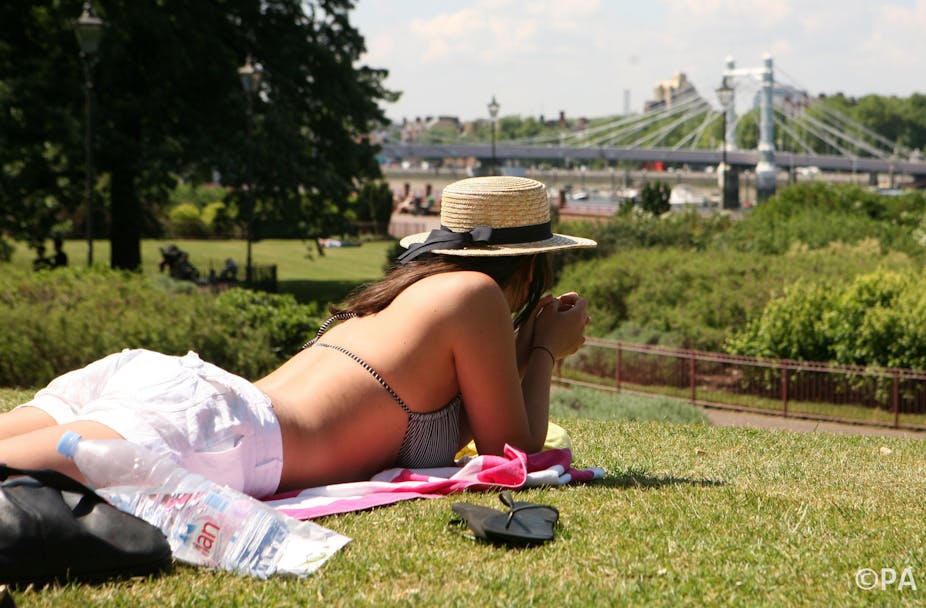A new study sheds light on why natural spaces in cities can help keep us healthy. Researchers found that people living in neighbourhoods with a large amount of green space, such as parks or playing fields, had lower stress levels. They also found that women were particularly affected: those with little neighbourhood green space showed higher stress levels than men in the same situation.
The research is part of wider efforts to understand why green space seems to be good for many aspects of human health. There is good evidence from the UK and elsewhere that suggests it leads to lower blood pressure, better mental health, and reduced risks of being overweight or dying from heart disease.
Importantly, this relationship remains after researchers account for how affluent or deprived an area is. When we consider the growing impact on society of the sort of chronic illnesses that green space could help to reduce, it’s easy to see why there’s so much interest in the connection.
But how, exactly, does green space benefit our health? The jury is still out on this one, but there are a few key suspects (and they may all be in on it together). First, green spaces may encourage us to be more physically active, such as going for a walk or a jog. Second, they may enhance our opportunities for social interaction with others. And third, they may help to relieve stress and mental fatigue. Each of these - lack of exercise, poor social relationships and stress - are known to lead to health problems, so it’s not surprising that improving them could improve our health.
This latest study pursued the stress-relieving hypothesis, by investigating how different amounts of green space in a neighbourhood related to the stress levels of unemployed people living in deprived areas of Dundee, Scotland. The research team was led by Dr Jenny Roe of Edinburgh’s Heriot-Watt University, along with members from the Universities of Edinburgh, Glasgow and Westminster, the James Hutton Institute and Biomathematics and Statistics Scotland.
The levels of the hormone cortisol in participants’ saliva were measured every three hours, as it is a good indicator of stress levels. Cortisol concentrations peak in the early morning and subsequently decline through the day: individuals with more stress exhibit slower declines than less stressed people. To complement the tests a questionnaire survey was also used to measure perceptions of their own stress levels.
It transpired that both men and women in neighbourhoods with more green space had lower levels of self-reported stress and sharper declines of cortisol than those in less green areas. So it seems that living in a greener area appeared to counteract at least some of the negative effects of urban deprivation. It’s well known that poverty and living in a poor environment is bad for health, so this finding is very significant.
Researchers in the Netherlands also found evidence that green spaces can provide a cushion against the negative health impact of stressful life events. And an earlier study in England found that excess deprivation-related mortality – the “health gap” between the richest and poorest – was smallest in the greenest neighbourhoods. How this occurred was unclear. This new study contributes one promising explanation: that large amounts of greenery promote better health in deprived populations.
Interestingly, those participants in the study living in areas with little green space were more stressed overall, but women were especially so. They not only self-described as more stressed than men in the questionnaire, but their cortisol measurements indicated chronic stress and exhaustion.
The results clearly suggest that women take the absence of green, open spaces harder than men. As five times as many women in the study were caring for family than were men, a shortage of local parks and play spaces for children may have affected women more keenly. But this needs further investigation.
By adding to the evidence for the stress-relieving properties and health benefits of green space, this study adds to the body of research that should inform urban planning and health policies in our cities. More work like this is needed to fine-tune such policies, by asking how green spaces influence stress in different places and among different population groups. A point that needs particular attention is the comparison of quality versus quantity, as other studies suggest that it is the quality of green space that drives women to use and therefore benefit from it, and this will be an important factor in the provisions made by town planners.

